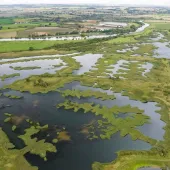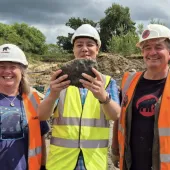Mammoth Hunting In Norfolk

By Dr Danielle Schreve, Royal Holloway University of London
In 2002 an ancient river meander channel filled with fossil bones and flint artefacts was revealed during aggregates quarrying by Ayton Products at Lynford in south-west Norfolk. The surviving remnant of this palaeochannel (fig. 1) was subsequently excavated by the Norfolk Archaeology Unit and collaborating specialists with funding from English Heritage via the Aggregates Levy Sustainability Fund.
The site dates to the middle of the last Ice Age (the Devensian) in Britain, around 60,000 years ago, a brief period of relative warmth when the environment was dominated by a rich steppe–tundra supporting hundreds of thousands of large herbivores. The site has superbly preserved fossil remains including pollen, plant fossils such as twigs and seeds, beetles, shells and vertebrates (mammals, fish, amphibians and birds). In combination, these indicate open conditions dominated by grasses and sedges with small stands of arctic dwarf trees and wetlands adjacent to a source of permanent water. Average summer temperatures would have ranged from 12–14°C with winter temperatures at or below –10°C.
Over 2,700 flint artefacts, including 47 pristine hand axes of classic Neanderthal type (fig. 2), were recovered from the site in conjunction with the animal remains, strongly suggesting that early humans had contributed in some way to the faunal accumulation. Initial speculation concerning the nature of the site focused on the possibility that it represented a locality where Neanderthals were killing and butchering large game, and a major aim of the research was to examine this possibility.
The remains of at least 11 woolly mammoths were identified among the large bone assemblage, together with smaller numbers of reindeer, woolly rhinoceros, horse, bison, brown bear, fox and wolf. Although large body parts, such as mammoth tusks, skulls and ribs, were still present at the site, it was apparent that the ‘meatiest’ large limb bones had gone. Predation by carnivores, such as spotted hyaena, can be dismissed, since evidence of gnawing occurred on less than 1% of the bones, nor had the bones been transported elsewhere by the river.
It seems likely, therefore, that these large bones were preferentially removed by Neanderthals, presumably to an area of higher ground away from the river where they could be consumed in safety. Most of the mammoths were prime adult animals, suggesting deliberate predation by early humans, and evidence of disease is unusually frequent, most of it in key ‘target’ areas of the body. It is possible, therefore, that Neanderthals were selecting vulnerable individuals and driving them towards the channel where they may have become mired and could be more easily despatched.
Lynford is one of the most significant archaeological discoveries of the last 50 years, providing a fascinating glimpse of early human behaviour during the last Ice Age. The project is an excellent model for co-operation between professional archaeologists, university specialists and the aggregates industry, and continues to be widely publicized in national and international media.








